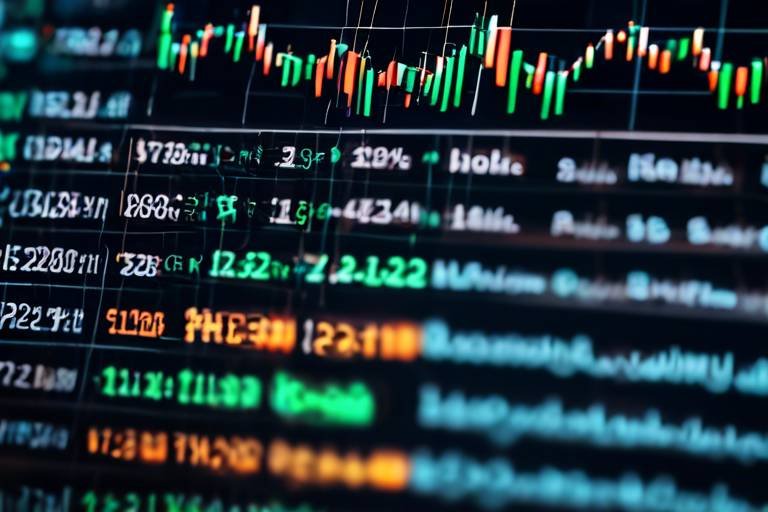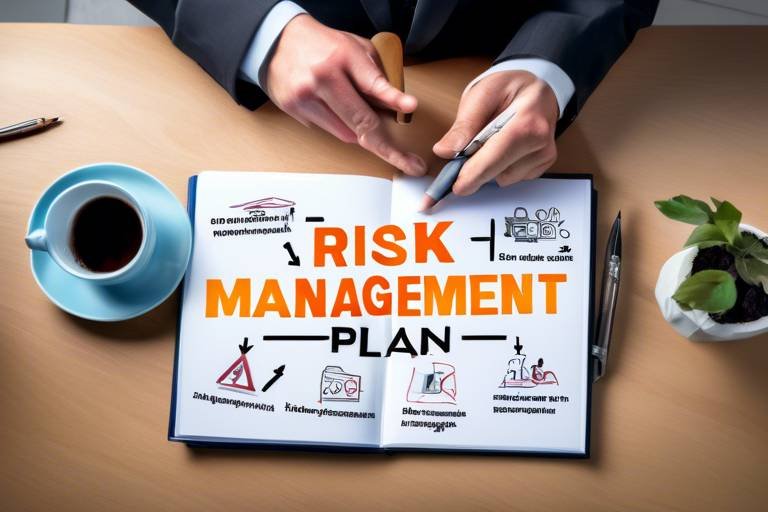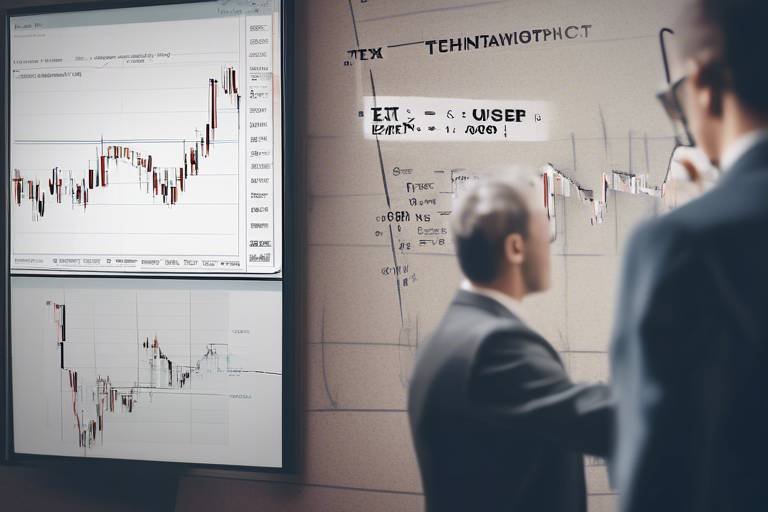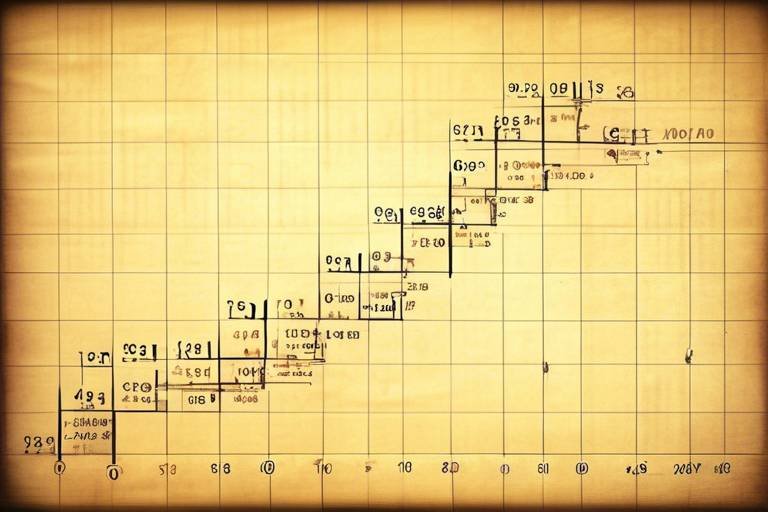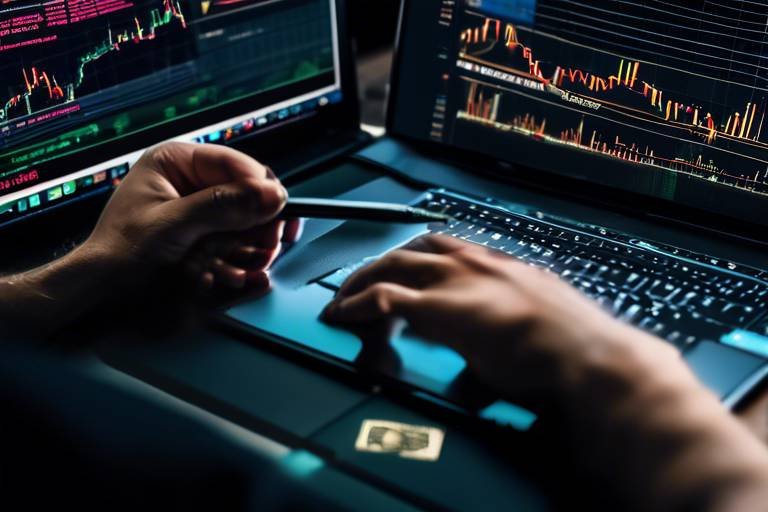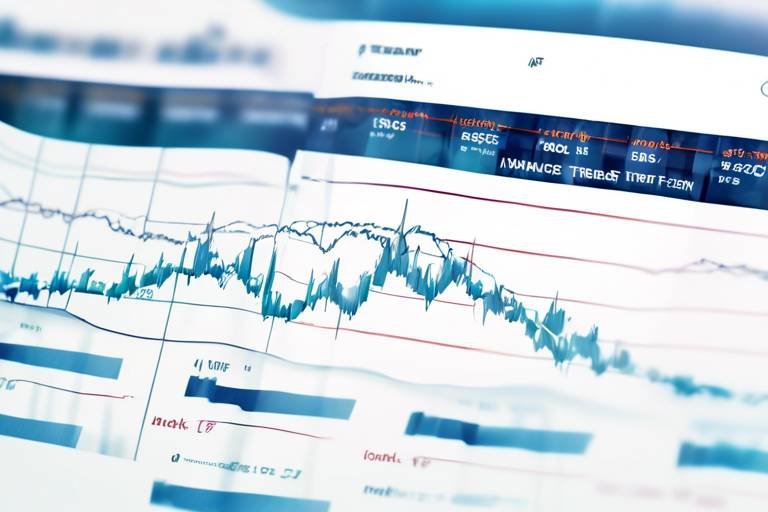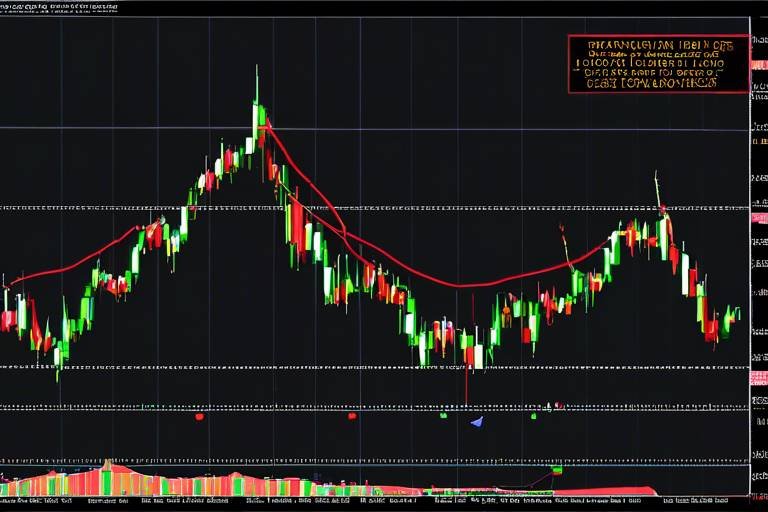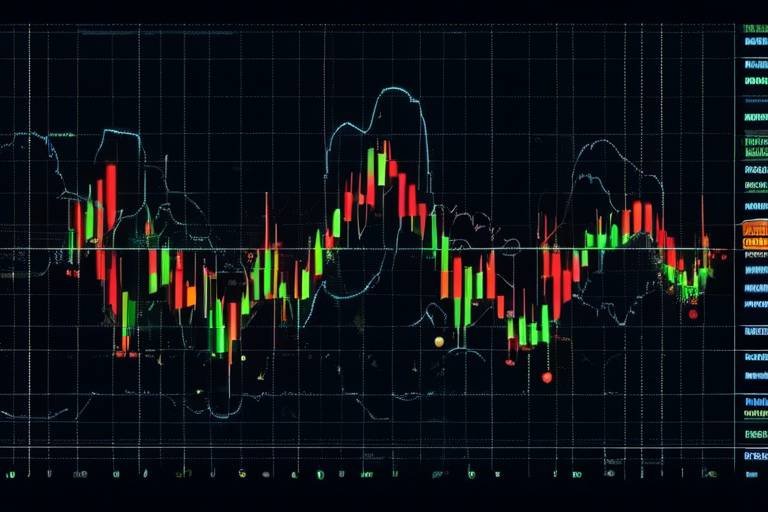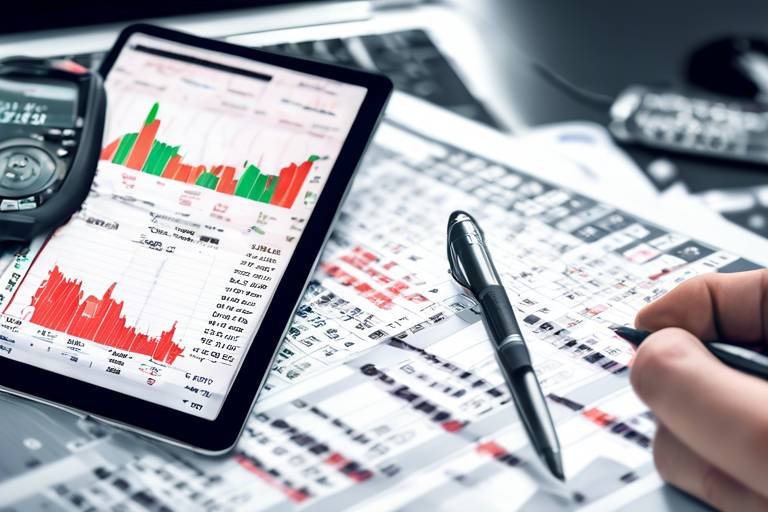How to Analyze Cryptocurrency Charts for Trading Insights
In the fast-paced world of cryptocurrency trading, understanding how to analyze charts effectively can be the difference between profit and loss. With the market constantly fluctuating, traders need to develop a keen eye for spotting trends and making informed decisions. This article dives deep into the essential techniques for analyzing cryptocurrency charts, equipping you with the knowledge to navigate this volatile landscape confidently. Whether you're a seasoned trader or just starting, mastering chart analysis is crucial for enhancing your trading skills and maximizing your returns.
Candlestick patterns are the bread and butter for traders, offering a visual representation of market sentiment. Each candlestick reflects the price movement over a specific period, showing the open, close, high, and low prices. By studying these patterns, traders can glean insights into potential market movements. For instance, a series of bullish candlesticks may indicate increasing buyer interest, while bearish patterns could signal a downturn. Some of the most common candlestick patterns include:
- Doji: Indicates indecision in the market.
- Hammer: Suggests a potential reversal after a downtrend.
- Engulfing Patterns: Signal strong buying or selling pressure.
Understanding these patterns can significantly enhance your ability to predict future price movements, making it an essential skill for any trader.
Technical indicators are your best friends when it comes to analyzing cryptocurrency charts. They help you make sense of the price data and identify trends or potential reversals. Some of the most popular indicators include Moving Averages, Relative Strength Index (RSI), and the Moving Average Convergence Divergence (MACD). Each of these tools serves a unique purpose and can provide valuable insights into market behavior.
Moving averages are fundamental indicators that smooth out price data to help identify trends over specific periods. They can be incredibly helpful in filtering out the noise from random price fluctuations. There are two primary types of moving averages: the Simple Moving Average (SMA) and the Exponential Moving Average (EMA). Each has its own strengths and weaknesses, depending on your trading strategy.
The Simple Moving Average (SMA) is calculated by taking the average of a set number of prices over a specified time frame. For example, a 10-day SMA takes the closing prices of the last ten days and divides them by ten. This indicator is particularly useful for identifying support and resistance levels. When the price is above the SMA, it may indicate an uptrend, while prices below the SMA may suggest a downtrend.
On the other hand, the Exponential Moving Average (EMA) gives more weight to recent prices, making it more responsive to price changes. This characteristic can be advantageous for traders looking to catch trends early. The EMA can help identify potential entry and exit points, making it a favored tool among day traders.
The Relative Strength Index (RSI) is another indispensable tool that measures the speed and change of price movements. Ranging from 0 to 100, the RSI helps traders identify overbought or oversold conditions. Typically, an RSI above 70 indicates that an asset is overbought, while an RSI below 30 suggests it is oversold. This information can be crucial for making timely trading decisions.
Volume analysis is a powerful technique that offers insights into the strength of price movements. By examining trading volume, traders can better understand whether a price movement is backed by strong interest or if it's merely a fleeting spike. High volume during a price increase typically indicates strong buying interest, while high volume during a price decrease suggests strong selling pressure.
Recognizing volume trends can significantly enhance your trading strategies. For instance, if you notice an increase in volume accompanying a price rise, it could indicate a strong bullish trend. Conversely, if the price is rising but volume is decreasing, it may be a sign that the trend is losing momentum. By paying attention to these volume trends, you can make more informed trading decisions.
Various volume indicators can provide additional insights into market dynamics. Tools like On-Balance Volume (OBV) and the Volume Oscillator can help traders gauge the strength of price movements. The OBV, for example, adds volume on up days and subtracts it on down days, providing a cumulative total that can indicate potential price trends.
Chart patterns are formations that can indicate future price movements. Understanding these patterns can give you a significant edge in predicting market behavior. Some key patterns to watch include:
- Head and Shoulders: A reliable reversal signal.
- Triangles: Indicate potential continuation of a trend.
- Flags: Short-term continuation patterns that can lead to significant price movements.
By recognizing these patterns early, traders can position themselves to capitalize on upcoming price movements.
Effective risk management is essential for successful trading. Without it, even the best analysis can lead to significant losses. Strategies like setting stop-loss orders and determining optimal position sizes can help protect your capital and minimize risks.
Stop-loss orders are crucial for limiting potential losses. By placing a stop-loss order at a predetermined level, you can automatically sell your asset if it falls to that price, protecting your investment from further declines. It's vital to set these levels based on technical analysis and market conditions to ensure they are effective.
Position sizing determines how much to invest in each trade, balancing risk and reward. Various techniques can help you calculate optimal position sizes, ensuring you don't overexpose yourself to risk. For instance, using a percentage of your trading capital for each trade can help you maintain a consistent risk level across your portfolio.
1. What is the best way to start analyzing cryptocurrency charts?
Start by familiarizing yourself with candlestick patterns and key technical indicators. Practice analyzing charts on different time frames to develop your skills.
2. How can I improve my trading decisions?
Incorporate both technical and fundamental analysis into your trading strategy. Stay updated on market news and trends to make informed decisions.
3. What are the most common mistakes traders make when analyzing charts?
Common mistakes include relying too heavily on one indicator, ignoring volume trends, and failing to implement effective risk management strategies.

Understanding Candlestick Patterns
Candlestick patterns are the heartbeat of trading in the cryptocurrency market. They provide a visual representation of price movements over a specific period, allowing traders to gauge market sentiment at a glance. Imagine each candlestick as a tiny story, narrating the battle between buyers and sellers. When you learn to read these patterns, you unlock a powerful tool that can guide your trading decisions.
Each candlestick consists of four key components: the open, high, low, and close prices. The body of the candlestick is formed between the open and close prices, while the wicks (or shadows) extend to the high and low prices. A candlestick can be bullish (typically green or white) when the closing price is higher than the opening price, indicating that buyers are in control. Conversely, a bearish candlestick (often red or black) shows that sellers have taken over, closing the price lower than it opened. This simple visual cue can speak volumes about market trends.
There are several common candlestick patterns that traders should familiarize themselves with, as each pattern can signal potential price movements. Some of the most significant patterns include:
- Doji: A doji occurs when the opening and closing prices are virtually the same, signaling indecision in the market.
- Hammer: This bullish reversal pattern has a small body and a long lower wick, suggesting that buyers are stepping in after a downtrend.
- Engulfing Patterns: A bullish engulfing pattern occurs when a small bearish candle is followed by a larger bullish candle, indicating a potential reversal.
- Morning Star: A three-candle pattern that signals a bullish reversal after a downtrend, consisting of a long bearish candle, a short candle, and a long bullish candle.
Understanding these patterns is not just about memorizing them; it's about interpreting what they mean in the context of market conditions. For example, a hammer pattern appearing after a significant downtrend can signal a potential reversal, while a doji at the peak of an uptrend might indicate that the trend is losing momentum.
Moreover, combining candlestick patterns with other technical indicators can enhance your analysis. For instance, if a bullish engulfing pattern coincides with an oversold RSI, it strengthens the case for a potential price increase. This synergy between different tools can significantly improve your trading strategy.
In conclusion, mastering candlestick patterns is essential for any trader looking to navigate the volatile waters of cryptocurrency trading effectively. By paying attention to these visual cues and understanding their implications, you can make more informed trading decisions and potentially enhance your profitability.
What are candlestick patterns?
Candlestick patterns are formations created by the price movements of an asset over time. They help traders interpret market sentiment and predict future price movements.
Why are candlestick patterns important in trading?
Candlestick patterns provide visual insights into market behavior and can indicate potential reversals or continuations in price trends, aiding traders in making informed decisions.
How can I learn to read candlestick patterns?
Practice is key! Start by studying common patterns, use trading simulators, and analyze historical charts. Over time, you'll become more comfortable identifying and interpreting these patterns.

Key Technical Indicators
When it comes to trading cryptocurrencies, understanding technical indicators is like having a secret weapon in your arsenal. These indicators serve as vital tools that help traders decipher the complex language of market movements. By analyzing price patterns, volume, and momentum, traders can make informed decisions that can lead to profitable outcomes. In this section, we will dive into some of the most popular technical indicators, including Moving Averages, Relative Strength Index (RSI), and Moving Average Convergence Divergence (MACD). Each of these indicators offers unique insights into market trends and potential reversals, allowing traders to navigate the often turbulent waters of cryptocurrency trading.
Let’s start with Moving Averages. These indicators are particularly useful for smoothing out price data over a specific time frame, making it easier to identify whether a cryptocurrency is in an upward or downward trend. Moving Averages can be broken down into two main types: the Simple Moving Average (SMA) and the Exponential Moving Average (EMA). While the SMA calculates the average price over a set period, the EMA gives more weight to recent prices, making it more responsive to new information. This responsiveness can be crucial for traders looking to catch trends early.
Understanding how to apply these Moving Averages can significantly enhance your trading strategy. For instance, many traders use the crossover method, where they look for points where a short-term moving average crosses above or below a long-term moving average. This can signal potential buy or sell opportunities. Let’s take a closer look at each type:
| Type | Description | Use in Trading |
|---|---|---|
| Simple Moving Average (SMA) | Averages the closing prices over a specific period. | Identifies support and resistance levels. |
| Exponential Moving Average (EMA) | Gives more weight to the most recent prices. | More responsive to price changes, ideal for spotting trends. |
Next up is the Relative Strength Index (RSI). This momentum oscillator measures the speed and change of price movements, providing insights into whether a cryptocurrency is overbought or oversold. The RSI ranges from 0 to 100, with levels above 70 typically indicating that an asset is overbought, while levels below 30 suggest it is oversold. By keeping an eye on these levels, traders can make educated guesses on potential price corrections.
Finally, we have the Moving Average Convergence Divergence (MACD). This indicator is a bit more complex but incredibly useful. It consists of two moving averages (the MACD line and the signal line) and is used to identify potential buy and sell signals based on the convergence and divergence of these two lines. When the MACD line crosses above the signal line, it may indicate a bullish trend, while a crossover below could suggest a bearish trend. Understanding how to interpret these signals can provide traders with a significant edge in their trading decisions.
In summary, mastering these key technical indicators can dramatically improve your trading strategies. By combining the insights from Moving Averages, RSI, and MACD, traders can develop a comprehensive view of market conditions, helping them to make more informed decisions and ultimately enhance their profitability.
1. What are technical indicators in cryptocurrency trading?
Technical indicators are mathematical calculations based on the price, volume, or open interest of a security. They help traders analyze market trends and make informed trading decisions.
2. How do I choose the right technical indicators?
The right indicators depend on your trading strategy. Beginners might start with simple indicators like Moving Averages and RSI, while advanced traders may incorporate MACD and Bollinger Bands for more complex analysis.
3. Can I rely solely on technical indicators for trading?
While technical indicators are incredibly useful, they should not be the only factor in your trading decisions. It's important to consider market news, sentiment, and other external factors.

Moving Averages Explained
When it comes to analyzing cryptocurrency charts, moving averages are like the compass guiding traders through the often-turbulent waters of the market. They help to smooth out price data by creating a constantly updated average price, which can be incredibly useful for identifying trends over specific periods. Think of moving averages as a way to clear the fog, allowing traders to see the underlying trend without the noise of daily price fluctuations.
There are two primary types of moving averages that traders typically focus on: the Simple Moving Average (SMA) and the Exponential Moving Average (EMA). Each has its own unique characteristics and applications, making them suitable for different trading strategies. The SMA is calculated by taking the average of a set number of past prices, while the EMA gives more weight to recent prices, making it more responsive to new information. This responsiveness can be crucial in fast-moving markets like cryptocurrencies.
To illustrate this further, let’s take a closer look at how these moving averages can be calculated:
| Type of Moving Average | Calculation Method | Use Case |
|---|---|---|
| Simple Moving Average (SMA) | Sum of closing prices over a set period / Number of periods | Identifying overall trends |
| Exponential Moving Average (EMA) | Current price x (k) + Previous EMA x (1 - k), where k 2 / (N + 1) | Spotting quick trend changes |
Understanding how to use these moving averages effectively can significantly enhance your trading strategy. For instance, traders often look for crossovers between the SMA and EMA as potential buy or sell signals. When the shorter-term EMA crosses above the longer-term SMA, it can indicate a bullish trend, while a crossover in the opposite direction may signal a bearish trend.
Moreover, moving averages can also act as dynamic support and resistance levels. When the price approaches a moving average from above, it may find support, while approaching from below could indicate resistance. This dynamic nature makes moving averages an essential tool in a trader's arsenal.
In summary, moving averages are not just numbers on a chart; they are powerful indicators that can help you navigate the complexities of cryptocurrency trading. By understanding their calculations, applications, and how to interpret them in the context of market movements, you can make more informed trading decisions that align with your strategy.
- What is the main difference between SMA and EMA? The SMA gives equal weight to all prices over the period, while the EMA gives more weight to recent prices, making it more sensitive to price changes.
- How do I choose the right period for moving averages? The choice of period depends on your trading strategy; shorter periods (e.g., 10 or 20 days) are useful for day trading, while longer periods (e.g., 50 or 200 days) are better for long-term trends.
- Can moving averages guarantee profits? No, moving averages are tools to aid in decision-making but do not guarantee profits. They should be used in conjunction with other indicators and analysis methods.

Simple Moving Average (SMA)
The is one of the most fundamental and widely used indicators in technical analysis. It serves as a vital tool for traders looking to identify trends and potential reversals in the cryptocurrency market. Essentially, the SMA calculates the average price of a cryptocurrency over a specified number of periods, smoothing out price fluctuations and providing a clearer picture of the overall trend. For instance, a 50-day SMA takes the average closing prices of the last 50 days and plots it on the chart, helping traders visualize the trend direction.
One of the key reasons traders rely on the SMA is its simplicity. By focusing on an average, it reduces the noise caused by daily price volatility. This makes it easier for traders to make informed decisions. However, it’s important to remember that while the SMA is a powerful tool, it has its limitations. For example, it reacts slowly to price changes because it gives equal weight to all price points within the selected period. This means that in a rapidly changing market, the SMA might lag behind the current price action.
To illustrate how the SMA works, consider the following table that outlines the calculation of a 5-day SMA:
| Day | Closing Price |
|---|---|
| 1 | $100 |
| 2 | $105 |
| 3 | $102 |
| 4 | $107 |
| 5 | $110 |
To calculate the 5-day SMA, you would add the closing prices for those five days and divide by 5:
SMA (100 + 105 + 102 + 107 + 110) / 5 SMA 524 / 5 SMA $104.80
This calculated SMA value can then be plotted on a chart, allowing traders to see how it aligns with the current price movements. When the price is above the SMA, it often indicates a bullish trend, whereas a price below the SMA might suggest a bearish trend. Additionally, traders frequently use crossovers as signals; for example, if a short-term SMA crosses above a long-term SMA, it could be a signal to buy, while the opposite crossover might indicate a sell signal.
In conclusion, the Simple Moving Average is a powerful yet straightforward tool for traders. By understanding its calculation and application, traders can better navigate the complexities of the cryptocurrency market and make more informed decisions. However, it’s crucial to combine the SMA with other indicators and analysis techniques to enhance its effectiveness and mitigate the risks associated with trading.
- What is the best period for calculating SMA? The best period can vary based on trading strategy. Shorter periods (like 5 or 10 days) are often used for day trading, while longer periods (like 50 or 200 days) are more common in long-term trading.
- Can I use SMA for all cryptocurrencies? Yes, SMA can be applied to any cryptocurrency, but it’s important to consider the unique volatility and market conditions of each asset.
- How does SMA differ from EMA? While both are moving averages, the Exponential Moving Average (EMA) gives more weight to recent prices, making it more responsive to price changes compared to the SMA.

Exponential Moving Average (EMA)
The is a powerful tool in the arsenal of any cryptocurrency trader. Unlike the Simple Moving Average (SMA), which gives equal weight to all prices over a specified period, the EMA places greater emphasis on the most recent prices. This characteristic makes the EMA more responsive to price changes, allowing traders to react to market movements more quickly. Essentially, the EMA can be seen as a magnifying glass that highlights the latest trends, making it easier to spot potential trading opportunities.
To calculate the EMA, you need to follow a specific formula that incorporates the previous EMA value and the current price. The formula is as follows:
EMA (Current Price x Multiplier) + (Previous EMA x (1 - Multiplier))
Where the Multiplier is calculated using the formula:
Multiplier 2 / (N + 1)
Here, N represents the number of periods you want to analyze. For example, if you're looking at a 10-day EMA, N would be 10. This means that the EMA will react more quickly to price changes than the SMA, making it particularly useful in volatile markets like cryptocurrency.
One of the key advantages of using the EMA is its ability to help traders identify trends and reversals. When the price is above the EMA, it indicates a bullish trend, while a price below the EMA suggests a bearish trend. Traders often use the EMA in conjunction with other indicators to confirm their trading strategies. For instance, a common practice is to look for crossovers between short-term and long-term EMAs.
To illustrate this, consider the following example of two EMAs:
| Period | Short-term EMA (5-day) | Long-term EMA (20-day) |
|---|---|---|
| Day 1 | $100 | $95 |
| Day 2 | $102 | $96 |
| Day 3 | $101 | $97 |
| Day 4 | $103 | $98 |
| Day 5 | $105 | $99 |
| Day 6 | $107 | $100 |
| Day 7 | $108 | $101 |
| Day 8 | $110 | $102 |
| Day 9 | $109 | $103 |
| Day 10 | $111 | $104 |
In this example, if the 5-day EMA crosses above the 20-day EMA, it could signal a buying opportunity, while a cross below might indicate a selling opportunity. This strategy, known as the EMA crossover strategy, is widely used by traders to make informed decisions.
However, it's essential to remember that no indicator is foolproof. The EMA, while helpful, should be used alongside other analysis tools and techniques to create a well-rounded trading strategy. For instance, incorporating volume analysis or candlestick patterns can provide additional context to your trades, reducing the risk of false signals.
In conclusion, the Exponential Moving Average is a dynamic tool that can enhance your trading strategy by providing timely insights into market trends. By understanding how to calculate and apply the EMA effectively, you can position yourself to make more informed trading decisions in the ever-changing world of cryptocurrency.
- What is the main difference between EMA and SMA? The EMA gives more weight to recent prices, making it more responsive to price changes compared to the SMA, which treats all prices equally.
- How can I use EMA in my trading strategy? Traders often use EMA crossovers, where a short-term EMA crossing above a long-term EMA signals a potential buy, and vice versa for a sell signal.
- Is EMA suitable for all trading styles? Yes, EMA can be used in various trading styles, including day trading, swing trading, and long-term investing, but it works best in trending markets.

Relative Strength Index (RSI)
The is a powerful momentum oscillator that measures the speed and change of price movements. Developed by J. Welles Wilder Jr., this indicator is designed to identify overbought or oversold conditions in a market, helping traders make informed decisions. The RSI ranges from 0 to 100, and it is typically plotted on a scale of 0 to 100 beneath the price chart. But what does this really mean for traders? Well, it can signal potential reversals in price trends, allowing you to capitalize on market movements.
When you look at an RSI reading, the general rule of thumb is that readings above 70 indicate an overbought condition, while readings below 30 suggest an oversold condition. This is where the magic happens: traders often use these levels to identify potential entry and exit points. For instance, if the RSI climbs above 70, it might be a signal that the asset is overbought and due for a price correction. Conversely, if the RSI dips below 30, it could indicate that the asset is oversold, potentially presenting a buying opportunity. But hold on, it's not that simple!
Traders should also consider the context of these readings. For example, during a strong bullish trend, the RSI may remain above 70 for extended periods without a significant price correction. Similarly, in a bearish market, the RSI might stay below 30. This is why it's crucial to combine the RSI with other technical indicators and chart patterns to confirm signals and refine your trading strategy.
Understanding how to interpret RSI readings involves looking for divergences as well. A divergence occurs when the price of an asset moves in the opposite direction of the RSI. For example, if the price is making new highs while the RSI is making lower highs, this could indicate a weakening trend and a potential reversal. Such insights can be incredibly valuable for traders looking to maximize their profits while minimizing risk.
| RSI Level | Market Condition | Implication |
|---|---|---|
| Above 70 | Overbought | Possible price correction |
| Below 30 | Oversold | Possible buying opportunity |
In summary, the RSI is not just a standalone indicator; it's a crucial part of a trader's toolkit. By understanding its readings and applying them within the broader context of the market, you can enhance your trading strategies significantly. So, whether you're a seasoned trader or just starting, the RSI can provide valuable insights that help you navigate the often turbulent waters of cryptocurrency trading.
- What is the best RSI setting for trading? The default setting is typically 14 periods, but some traders adjust this based on their trading style and the asset's volatility.
- Can RSI be used with other indicators? Absolutely! Combining RSI with other indicators like Moving Averages or MACD can provide more reliable signals.
- How often should I check the RSI? It depends on your trading strategy. Day traders might check it multiple times a day, while swing traders may look at it less frequently.

Volume Analysis
When diving into the world of cryptocurrency trading, one cannot overlook the significance of . Volume, in simple terms, refers to the number of assets traded during a specific period. Understanding volume is like having a secret weapon in your trading arsenal. It provides insights into the strength and sustainability of price movements, helping traders gauge whether a trend is likely to continue or reverse. Think of volume as the fuel that drives the price action; without it, even the most promising trends can fizzle out.
To effectively analyze volume, traders often look for patterns and correlations between price movements and trading volume. A price increase accompanied by high volume indicates strong buying interest, suggesting that the trend may continue. Conversely, if a price rises but volume is low, it may signal a lack of conviction among traders, hinting that the movement might not be sustainable. Therefore, recognizing the interplay between price and volume is crucial for making informed trading decisions.
One of the most effective ways to interpret volume is by examining volume trends. Identifying bullish and bearish volume trends can significantly enhance your trading strategies. For instance, if you notice a series of increasing volume bars during an uptrend, it indicates that more buyers are entering the market, which is a positive sign. On the flip side, if you see a downtrend accompanied by increasing volume, it suggests that sellers are gaining control, and the price might continue to drop.
Additionally, traders often utilize various volume indicators to further refine their analysis. Some popular volume indicators include:
- On-Balance Volume (OBV): This indicator uses volume flow to predict changes in stock price. It adds volume on up days and subtracts volume on down days, helping traders understand whether the buying or selling pressure is stronger.
- Volume Oscillator: This tool measures the difference between two volume moving averages. It helps traders identify trends and potential reversals based on volume changes.
Incorporating these indicators into your trading strategy can provide a more comprehensive view of market dynamics. By analyzing volume alongside price movements, you can make more informed decisions, reducing the risk of entering trades based on false signals. Remember, in the world of cryptocurrency trading, knowledge is power, and understanding volume is a key component of that knowledge.
Q: Why is volume important in cryptocurrency trading?
A: Volume indicates the strength of price movements. High volume during price increases suggests strong buying interest, while low volume may indicate weak trends.
Q: How can I analyze volume trends?
A: Look for patterns in volume alongside price movements. Increasing volume during an uptrend is a bullish sign, while increasing volume in a downtrend indicates bearish sentiment.
Q: What are some common volume indicators?
A: Popular volume indicators include On-Balance Volume (OBV) and Volume Oscillator, which help traders assess buying and selling pressure in the market.

Identifying Volume Trends
When it comes to trading cryptocurrencies, understanding volume trends can be a game changer. Volume, which refers to the total amount of a cryptocurrency traded during a specific time frame, is a crucial indicator of market strength and potential price movements. Have you ever noticed how a sudden spike in trading volume often precedes a significant price change? This is no coincidence! By identifying these volume trends, traders can make more informed decisions and enhance their trading strategies.
To effectively identify volume trends, you should consider a few key aspects:
- Rising Volume with Price Increase: When the price of a cryptocurrency rises along with increasing volume, it indicates strong buyer interest and confirms the bullish trend.
- Rising Volume with Price Decrease: Conversely, if the price is falling while volume is increasing, this may signal strong selling pressure, potentially indicating a bearish trend.
- Declining Volume with Price Increase: If the price goes up but volume is decreasing, it may suggest a lack of conviction among buyers, which could lead to a price reversal.
- Declining Volume with Price Decrease: A drop in price accompanied by declining volume can indicate that sellers are losing interest, possibly signaling a bottom.
These volume trends can be visually represented on a chart, allowing traders to quickly assess market conditions. For instance, consider the following hypothetical volume data for a cryptocurrency over a week:
| Day | Price ($) | Volume (Units) |
|---|---|---|
| Monday | 50 | 1000 |
| Tuesday | 52 | 1500 |
| Wednesday | 54 | 1200 |
| Thursday | 53 | 800 |
| Friday | 55 | 2000 |
In this example, notice how the price increased from Monday to Friday, but the volume fluctuated. The spike in volume on Friday, combined with the price increase, indicates strong buying interest, suggesting that traders may want to consider this momentum in their decisions.
Moreover, it’s essential to keep an eye on volume during significant price levels, such as support and resistance. A breakout above resistance with high volume can confirm the strength of the price movement, while a breakdown below support with high volume can signal a potential downtrend.
In summary, identifying volume trends is not just about looking at numbers; it's about understanding the story behind those numbers. By analyzing how volume interacts with price movements, traders can gain valuable insights into market sentiment and make more strategic trading decisions. So, next time you look at a cryptocurrency chart, remember to pay attention to the volume—it might just reveal the hidden clues you need!
1. What does high trading volume indicate?
High trading volume typically indicates strong interest in a cryptocurrency, suggesting that the price movement is backed by a solid number of buyers or sellers.
2. Can low volume be a bad sign?
Yes, low volume can be a warning sign as it may indicate a lack of interest in the asset, leading to potential volatility and unpredictable price movements.
3. How can I track volume trends effectively?
You can track volume trends using various charting tools and platforms that provide volume indicators alongside price charts. Look for patterns and changes in volume relative to price movements.
4. Should I always rely on volume trends for trading decisions?
While volume trends are important, they should be used in conjunction with other indicators and analysis techniques for a more comprehensive trading strategy.

Volume Indicators
When diving into the world of cryptocurrency trading, understanding is crucial for gaining insights into market dynamics. These indicators help traders gauge the strength of price movements and confirm trends, making them essential tools in a trader's arsenal. But what exactly are volume indicators, and how can they enhance your trading strategy?
Volume indicators measure the number of assets traded over a specific period, providing a clearer picture of market activity. High trading volume often indicates strong interest in a particular asset, while low volume may suggest a lack of interest or uncertainty among traders. By analyzing volume in conjunction with price movements, traders can make more informed decisions.
Here are some of the most popular volume indicators that traders often rely on:
- On-Balance Volume (OBV): This indicator uses volume flow to predict changes in price. Essentially, it adds volume on up days and subtracts volume on down days, creating a cumulative total. A rising OBV indicates that buyers are willing to step in, suggesting potential upward price movement.
- Volume Oscillator: The Volume Oscillator measures the difference between two volume moving averages. It helps traders identify bullish or bearish trends by showing whether volume is increasing or decreasing relative to its historical averages.
- Average Volume: This is simply the average number of shares traded over a specified period. It helps traders understand whether current volume is above or below average, providing context for price movements.
Incorporating these volume indicators into your trading strategy can significantly improve your ability to read the market. For example, if you notice a price increase accompanied by high volume, it often indicates strong buying interest, suggesting that the price may continue to rise. Conversely, if a price increase occurs with low volume, it could be a sign of a weak trend likely to reverse.
To illustrate how volume indicators work in practice, consider the following table that compares price movements with their corresponding volume indicators:
| Price Movement | Volume Indicator | Interpretation |
|---|---|---|
| Price increases with high volume | Rising OBV | Strong buying interest; potential continuation of trend |
| Price increases with low volume | Flat OBV | Weak trend; potential reversal |
| Price decreases with high volume | Falling OBV | Strong selling pressure; potential continuation of downtrend |
| Price decreases with low volume | Flat OBV | Weak trend; potential reversal |
In conclusion, volume indicators are invaluable tools that provide insights into market sentiment and help traders confirm trends. By understanding and utilizing these indicators, you can enhance your trading strategies and make more informed decisions in the ever-evolving cryptocurrency market.
Q: What is the most important volume indicator for cryptocurrency trading?
A: While there are several volume indicators, many traders find the On-Balance Volume (OBV) to be particularly useful due to its ability to indicate buying and selling pressure effectively.
Q: How can I use volume indicators in my trading strategy?
A: You can use volume indicators to confirm trends. For example, if a price trend is accompanied by increasing volume, it suggests that the trend is strong. Conversely, if the trend is accompanied by decreasing volume, it may indicate a reversal.
Q: Are volume indicators reliable in volatile markets?
A: Volume indicators can be less reliable in highly volatile markets, as rapid price changes can lead to misleading signals. It's essential to combine volume analysis with other technical indicators for better accuracy.

Chart Patterns to Watch
When diving into the world of cryptocurrency trading, one of the most exciting aspects is the ability to predict future price movements through chart patterns. These patterns act like a roadmap, guiding traders through the often tumultuous waters of market fluctuations. Understanding these formations can significantly enhance your trading strategy, allowing you to anticipate market behavior and make informed decisions. Let's explore some of the key chart patterns that every trader should keep an eye on.
First and foremost, the Head and Shoulders pattern is widely regarded as one of the most reliable reversal signals. This pattern consists of three peaks: a higher peak (the head) between two lower peaks (the shoulders). When traders identify this formation, it often indicates a shift in market sentiment, suggesting that a bullish trend may be reversing into a bearish one. Recognizing the Head and Shoulders pattern can be crucial for traders looking to capitalize on these market shifts. To identify it effectively, look for the following:
- Three peaks: left shoulder, head, and right shoulder.
- A neckline that connects the lows of the two shoulders.
- A breakout below the neckline, confirming the reversal.
Next up, we have the Triangles, which can be categorized into three types: ascending, descending, and symmetrical. Each type offers unique insights into market behavior. For instance, an ascending triangle typically indicates a bullish sentiment, while a descending triangle suggests a bearish outlook. Traders should pay attention to the breakout direction, as it can signal a strong price movement. Here's a quick breakdown:
| Triangle Type | Market Sentiment | Breakout Direction |
|---|---|---|
| Ascending Triangle | Bullish | Upward |
| Descending Triangle | Bearish | Downward |
| Symmetrical Triangle | Neutral | Either direction |
Another important chart pattern to watch is the Flags. These are continuation patterns that typically form after a strong price movement, indicating that the trend is likely to continue in the same direction after a brief pause. Flags can be either bullish or bearish, depending on the preceding price action. Recognizing a flag involves looking for a small price consolidation that resembles a rectangle, slanting against the prevailing trend. The breakout from this pattern usually leads to a continuation of the prior trend, making it a valuable signal for traders.
Understanding these chart patterns is not just about recognition; it's about integrating this knowledge into your overall trading strategy. By combining chart patterns with other technical indicators and volume analysis, traders can increase their chances of making profitable trades. Remember, the market is like a game of chess; each move you make should be calculated and strategic. Keep your eyes peeled for these patterns, and you may just find yourself one step ahead of the market.
1. What are chart patterns in cryptocurrency trading?
Chart patterns are formations created by the price movements of cryptocurrencies on a chart. They help traders predict future price movements based on historical data.
2. How do I identify a Head and Shoulders pattern?
To identify a Head and Shoulders pattern, look for three peaks: a higher peak (the head) between two lower peaks (the shoulders), along with a neckline that connects the lows of the shoulders.
3. What does an ascending triangle indicate?
An ascending triangle typically indicates bullish sentiment, suggesting that the price may break out upward after the pattern completes.
4. Can chart patterns guarantee profits?
While chart patterns can provide valuable insights, they do not guarantee profits. It's essential to use them in conjunction with other technical analysis tools and risk management strategies.

Head and Shoulders
The pattern is one of the most recognized and reliable reversal signals in the world of cryptocurrency trading. Imagine it as a mountain peak, where the head is the tallest point, flanked by two smaller shoulders. This formation typically indicates a shift in trend direction, often signaling that a bullish trend is about to turn bearish. Understanding how to identify this pattern can be a game-changer for traders looking to capitalize on market shifts.
To spot a Head and Shoulders pattern, traders look for three key components:
- Left Shoulder: This is formed when the price rises to a peak and then declines.
- Head: Following the left shoulder, the price rises again to a higher peak before declining once more.
- Right Shoulder: The price then rises again, but only to the same level as the left shoulder before declining again.
Once this pattern is confirmed, it often suggests a significant price drop is imminent. The neckline, which is drawn by connecting the lowest points of the two troughs, serves as a critical support level. A break below this neckline is a strong signal for traders to enter a short position, as it indicates that the trend is indeed reversing.
Here's a simple illustration of the Head and Shoulders pattern:
| Component | Description |
|---|---|
| Left Shoulder | Initial peak followed by a decline |
| Head | Higher peak followed by a decline |
| Right Shoulder | Final peak that is lower than the head |
| Neckline | Support line connecting the troughs |
It's crucial to note that while the Head and Shoulders pattern can provide valuable insights, it’s not infallible. Traders should always consider additional factors such as volume and other technical indicators to confirm the validity of the signal. For instance, a significant increase in volume during the formation of the right shoulder can enhance the reliability of the pattern.
In summary, mastering the Head and Shoulders pattern can greatly improve your trading strategy. By recognizing this formation and understanding its implications, you can make more informed decisions and potentially increase your profitability in the volatile world of cryptocurrency trading.
Q: How reliable is the Head and Shoulders pattern?
A: While the Head and Shoulders pattern is widely regarded as a strong reversal signal, no pattern is 100% reliable. It's best used in conjunction with other indicators and analysis methods.
Q: What does it mean if the Head and Shoulders pattern fails?
A: A failed Head and Shoulders pattern can indicate that the market is still bullish or that there is strong support preventing a price drop. Traders should always have a plan in place for such scenarios.
Q: Can the Head and Shoulders pattern occur in different time frames?
A: Yes, the Head and Shoulders pattern can appear on various time frames, from minutes to daily charts. However, patterns on longer time frames tend to be more reliable.

Triangles and Flags
Triangles and Flags are two of the most significant continuation patterns that traders often watch for in cryptocurrency charts. These patterns can provide valuable insights into potential price movements, helping traders make informed decisions. Understanding how to recognize these formations is essential for anyone looking to capitalize on market trends.
Triangles are characterized by converging trendlines that indicate a period of consolidation before a breakout occurs. There are three main types of triangle patterns:
- Ascending Triangle: This pattern typically indicates bullish sentiment, as the price makes higher lows while the resistance level remains constant.
- Descending Triangle: Conversely, this pattern suggests bearish sentiment, as the price makes lower highs while the support level remains constant.
- Symmetrical Triangle: This pattern can signify either bullish or bearish sentiment, depending on the breakout direction, as both the highs and lows converge towards a point.
Recognizing these patterns involves looking for the formation of higher lows in ascending triangles and lower highs in descending triangles. A breakout occurs when the price crosses above the upper trendline in an ascending triangle or below the lower trendline in a descending triangle. Traders often set their entry points just above the breakout level for ascending triangles and just below the breakout level for descending triangles.
On the other hand, Flag patterns are brief consolidations that occur after a strong price movement, resembling a flagpole followed by a rectangular shape. Flags can be either bullish or bearish:
- Bullish Flag: This pattern appears after a strong upward price movement, indicating a brief consolidation before a continuation of the upward trend.
- Bearish Flag: This pattern forms after a significant downward price movement, suggesting a temporary pause before the price continues to decline.
To identify a Flag pattern, traders look for a sharp price movement followed by a period of consolidation that moves against the prevailing trend. The breakout is confirmed when the price breaks above the upper boundary of the flag for bullish flags or below the lower boundary for bearish flags. The potential price target after the breakout can be estimated by measuring the length of the flagpole and projecting it from the breakout point.
Both Triangle and Flag patterns are essential tools in a trader's arsenal, providing critical insights into market behavior. By mastering these formations, traders can enhance their ability to predict future price movements and make more informed trading decisions. Remember, while these patterns can provide valuable signals, they should always be used in conjunction with other technical analysis tools and indicators for the best results.
Q: How reliable are Triangles and Flags in predicting price movements?
A: While no pattern is foolproof, Triangles and Flags are considered relatively reliable indicators of potential price movements when confirmed with other technical analysis tools.
Q: Can I use Triangles and Flags in any market?
A: Yes, these patterns can be applied in various markets, including stocks, forex, and cryptocurrencies, making them versatile tools for traders.
Q: How do I manage risk when trading based on these patterns?
A: It's crucial to use stop-loss orders and position sizing techniques to manage risk effectively when trading based on these patterns.

Risk Management Strategies
Effective risk management is the backbone of successful trading, especially in the volatile world of cryptocurrency. Without a solid plan to manage risk, even the most skilled traders can find themselves facing significant losses. Imagine walking a tightrope without a safety net—every step is a gamble. To avoid falling into the abyss of financial ruin, traders must adopt strategies that protect their investments while allowing for potential gains.
One of the most fundamental strategies in risk management is the use of stop-loss orders. These are pre-set orders that automatically sell a cryptocurrency when its price falls to a certain level. By establishing stop-loss orders, traders can limit their losses on a trade and ensure that they don’t hold onto a losing position for too long. For instance, if you buy Bitcoin at $50,000 and set a stop-loss at $48,000, your maximum loss is capped at $2,000. This strategy is akin to having a safety net; it allows you to take calculated risks without the fear of catastrophic loss.
Another critical aspect of risk management is position sizing. This involves determining how much capital to allocate to each trade based on your overall portfolio size and risk tolerance. A common rule of thumb is to risk no more than 1-2% of your total trading capital on a single trade. For example, if your portfolio is worth $10,000, risking 1% means you would only allow a loss of $100 on any given trade. This approach not only helps in preserving your capital but also allows for more opportunities to trade without the fear of losing everything in one go.
To further enhance your risk management strategy, consider diversifying your investments across different cryptocurrencies. By spreading your capital across various assets, you reduce the risk of a significant loss from any single investment. Think of it like not putting all your eggs in one basket; if one cryptocurrency performs poorly, others may still yield profits, balancing your overall portfolio performance.
Additionally, keep an eye on market conditions and adjust your strategies accordingly. For instance, if the market is particularly volatile, you might opt for tighter stop-loss levels or reduce your position sizes. Staying informed about market trends and news can provide valuable insights that influence your trading decisions. Remember, the goal of risk management is not just to prevent losses but to create a sustainable trading practice that allows you to thrive in the long run.
In summary, effective risk management strategies are essential for navigating the unpredictable waters of cryptocurrency trading. By implementing stop-loss orders, practicing sound position sizing, diversifying your investments, and remaining adaptable to market conditions, you can significantly enhance your trading resilience and increase your chances of long-term success.
- What is a stop-loss order? A stop-loss order is a pre-set order to sell a cryptocurrency when its price falls to a specific level, helping to limit potential losses.
- How do I determine my position size? You can determine your position size by calculating a percentage of your overall portfolio that you are willing to risk on a single trade, typically between 1-2%.
- Why is diversification important in trading? Diversification helps reduce risk by spreading investments across different assets, minimizing the impact of a poor-performing investment on your overall portfolio.

Setting Stop-Loss Orders
Setting stop-loss orders is one of the most crucial aspects of trading, especially in the highly volatile world of cryptocurrencies. Imagine you’re sailing a ship in turbulent waters; a stop-loss order acts as your safety net, ensuring that you don’t sink when the waves get too rough. Essentially, a stop-loss order is a pre-set instruction to sell a cryptocurrency when it reaches a certain price, which helps mitigate potential losses. But how do you determine that price? This is where technical analysis and market conditions come into play.
When setting a stop-loss order, it’s essential to consider both the market volatility and your personal risk tolerance. For instance, if you’re trading a highly volatile coin, you might want to set your stop-loss a little further away from the current price to avoid getting stopped out too early. Conversely, for a more stable asset, a tighter stop-loss could be appropriate. Here are some key factors to keep in mind:
- Support and Resistance Levels: These are price points where the asset has historically struggled to move above or below. Setting your stop-loss just below a support level can provide a safety margin.
- Percentage Method: Many traders choose to set their stop-loss based on a certain percentage of their entry price. For example, a common approach is to set a stop-loss at 5-10% below the entry price, depending on the asset's volatility.
- ATR (Average True Range): This technical indicator measures market volatility. By using ATR, you can set your stop-loss based on how much the asset typically moves, allowing for a more dynamic approach.
Additionally, it’s vital to regularly review and adjust your stop-loss orders as market conditions change. Think of it as adjusting the sails on your ship; you wouldn’t want to stick with the same settings if the winds shift. By keeping an eye on your stop-loss levels, you can protect your investments while allowing for potential growth. Remember, the goal is not just to avoid losses but to position yourself for profits as well.
While setting stop-loss orders can be straightforward, many traders make common mistakes that can lead to unnecessary losses. Here are a few pitfalls to watch out for:
- Setting Stop-Loss Too Tight: Being overly cautious can lead to frequent stop-outs, where you sell at a loss only to see the price rebound shortly after.
- Ignoring Market Conditions: Failing to adjust your stop-loss based on current market trends can expose you to greater risk.
- Emotional Trading: Letting emotions dictate your stop-loss decisions can lead to irrational choices. Stick to your trading plan!
In conclusion, setting effective stop-loss orders is a blend of art and science. By understanding market dynamics and employing solid strategies, you can safeguard your investments while navigating the exciting yet unpredictable waters of cryptocurrency trading.
1. What is a stop-loss order?
A stop-loss order is a trading tool that automatically sells a cryptocurrency when it reaches a specified price, limiting potential losses.
2. How do I determine the right stop-loss level?
The right stop-loss level can depend on various factors, including market volatility, support and resistance levels, and your personal risk tolerance.
3. Can I adjust my stop-loss order after it's set?
Yes, you can adjust your stop-loss order as market conditions change, ensuring that you're always protected against significant losses.
4. What happens if my stop-loss order is triggered?
When your stop-loss order is triggered, it becomes a market order, and your cryptocurrency will be sold at the next available market price.
5. Should I always use a stop-loss order?
While not mandatory, using a stop-loss order is highly recommended as it helps manage risk and protect your trading capital.

Position Sizing Techniques
When it comes to trading cryptocurrencies, understanding position sizing is paramount for managing risk effectively and maximizing potential returns. Position sizing refers to the amount of capital you allocate to a specific trade, and it plays a crucial role in your overall trading strategy. The right position size can help you withstand market volatility without jeopardizing your entire trading account. So, how do you determine the optimal position size for your trades? Let’s dive into some essential techniques.
One of the most popular methods for calculating position size involves the Risk Percentage Model. This model suggests that you should only risk a small percentage of your total trading capital on any single trade—typically between 1% to 3%. By adhering to this rule, you can minimize the impact of any single loss on your overall portfolio. For instance, if you have a trading account of $10,000 and decide to risk 2% on a trade, you would only risk $200. This approach not only protects your capital but also allows you to stay in the game longer, even during losing streaks.
To calculate your position size using the Risk Percentage Model, follow these steps:
- Determine your total trading capital.
- Decide on the percentage of your capital you are willing to risk per trade.
- Calculate the dollar amount you are willing to risk by multiplying your total capital by your risk percentage.
- Identify your stop-loss level to determine how much you could potentially lose per share or contract.
- Finally, divide your total risk amount by the amount you could lose per share to find your position size.
Another effective technique is the Fixed Dollar Amount Model, where you decide on a fixed dollar amount to risk on each trade, regardless of your total account size. For example, you might choose to risk $100 on every trade. This method simplifies your calculations and can help maintain consistency in your trading approach. However, keep in mind that this method may not account for the varying levels of risk associated with different trades, so it's essential to adjust your fixed amount based on the volatility of the asset you are trading.
For those who prefer a more sophisticated approach, the Kelly Criterion offers a mathematical formula to determine the optimal position size based on your trading strategy's win rate and the ratio of your average win to average loss. The formula is as follows:
f* (bp - q) / b
Where:
- f* fraction of your capital to wager
- b odds received on the wager
- p probability of winning
- q probability of losing (1 - p)
This formula can help you determine how much to invest in each trade based on your historical performance. However, it requires accurate data on your win rate and payout ratios, making it more suitable for experienced traders.
Ultimately, the key to successful position sizing lies in finding a method that aligns with your trading style and risk tolerance. Whether you choose the Risk Percentage Model, Fixed Dollar Amount Model, or the Kelly Criterion, consistency is crucial. Regularly review and adjust your position sizes based on your trading performance and market conditions to ensure that you are effectively managing your risk while pursuing your trading goals.
Q: What is the best position sizing technique for beginners?
A: For beginners, the Risk Percentage Model is often the best choice, as it helps limit potential losses and encourages disciplined trading habits.
Q: How often should I adjust my position sizes?
A: You should review and adjust your position sizes regularly, especially after experiencing significant gains or losses, or when your trading strategy evolves.
Q: Can I use multiple position sizing techniques simultaneously?
A: Yes, you can combine different techniques to create a more robust trading strategy. Just ensure that you remain consistent and aware of your overall risk exposure.
Frequently Asked Questions
- What are candlestick patterns and why are they important?
Candlestick patterns are visual representations of price movements in the market. They help traders gauge market sentiment and make decisions based on the psychological behavior of market participants. Recognizing these patterns can alert traders to potential price movements, making them a crucial tool in trading strategies.
- How do I use technical indicators in cryptocurrency trading?
Technical indicators, such as Moving Averages, RSI, and MACD, provide insights into market trends and potential reversals. By analyzing these indicators, traders can identify entry and exit points, helping them make informed decisions based on historical price data and market conditions.
- What is the difference between Simple Moving Average (SMA) and Exponential Moving Average (EMA)?
The Simple Moving Average (SMA) calculates the average price over a specific period, treating all prices equally. In contrast, the Exponential Moving Average (EMA) gives more weight to recent prices, making it more responsive to new information. Traders often use EMA for short-term trading, while SMA can be useful for longer-term trends.
- How can I interpret the Relative Strength Index (RSI)?
The RSI is a momentum oscillator that measures the speed and change of price movements. Readings above 70 indicate that an asset may be overbought, while readings below 30 suggest it may be oversold. Traders use these signals to identify potential reversal points in the market.
- What role does volume analysis play in trading?
Volume analysis helps traders understand the strength behind price movements. High trading volume during a price increase suggests strong buyer interest, while high volume during a price drop indicates strong selling pressure. This information can confirm trends and signal potential reversals, making volume a key component of technical analysis.
- What are common chart patterns to look for in trading?
Common chart patterns include Head and Shoulders, Triangles, and Flags. Each pattern has its own implications for future price movements. For example, a Head and Shoulders pattern often signals a reversal, while Triangles and Flags typically indicate continuation of the current trend. Recognizing these patterns can enhance trading strategies.
- How can I effectively manage risk in my trading?
Effective risk management involves setting stop-loss orders and determining position sizes. Stop-loss orders help limit potential losses by automatically selling an asset when it reaches a certain price. Position sizing techniques ensure that traders do not risk too much of their capital on any single trade, balancing risk and reward.
- What is a stop-loss order and how do I set it?
A stop-loss order is a predetermined price level at which a trader will sell an asset to limit losses. To set an effective stop-loss, traders should consider technical analysis, support and resistance levels, and current market conditions. This helps protect capital while allowing for potential gains.
- What techniques can I use for position sizing?
Position sizing techniques include the fixed dollar method, percentage risk method, and volatility-based sizing. These methods help traders determine how much capital to allocate to each trade based on their risk tolerance and market conditions, ensuring they maintain a balanced approach to trading.

